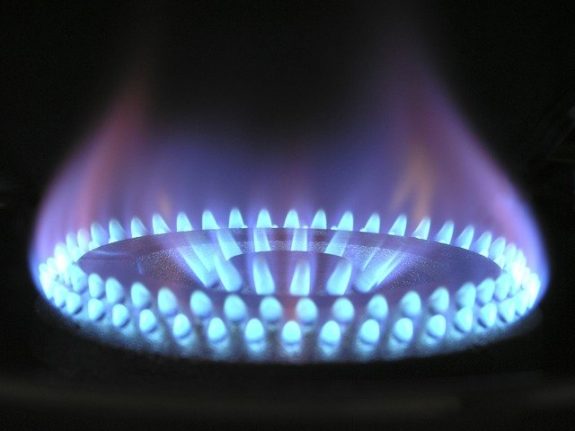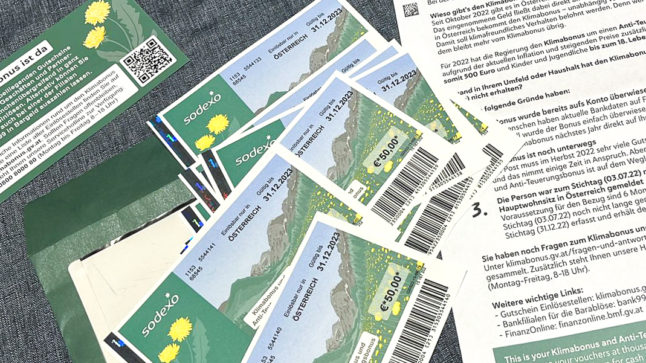On Tuesday, EU Energy Commissioner Kadri Simson met with representatives from the Organisation of the Petroleum Exporting Countries (OPEC), the International Atomic Energy Agency (IAEA) and Austria’s Environment and Energy Minister Leonore Gewessler (Greens).
The meeting took place in Vienna, where OPEC is headquartered, while the costs of implementing an embargo on all Russian energy sources (including oil and gas) were being calculated in Brussels.
Prior to the meeting in Austria’s capital city, Simson said: “We have to be ready, further crimes have to have severe consequences.”
READ MORE: Austria rejects embargo on Russian gas
Simson also took to Twitter to talk about her “energy outreach visit” in Vienna, which she said included listening to concerns from EU member states.
Meeting with the press📸at the start of my #energy outreach visit to Vienna 🇦🇹, outlining the plans & discussions ahead.
When we are facing challenges, it is crucial to understand the situation & the priorities, including concerns of the Member States. #EnergyTourEU🇪🇺⚡️ pic.twitter.com/KosJwcQoWO
— Kadri Simson (@KadriSimson) April 11, 2022
Austria has been vocal about its opposition to sanctions on Russian energy – mostly because the Alpine Republic is heavily reliant on imports of Russian gas, which accounts for 80 percent of the country’s entire gas consumption.
However, following further reports of atrocities against civilians in Ukraine, the EU is now preparing a fresh round of sanctions against Russia with a focus on energy supplies.
What could be in the next round of sanctions against Russia?
On April 7th, the EU announced a fifth round of sanctions against Russia, including a ban on the import of Russian coal from August.
It is now being reported that imports of other forms of Russian energy, such as oil and gas, will be targeted next by EU sanctions, but the exact details are still being negotiated.
EU Energy Commissioner Simson told journalists in Vienna that an emergency plan is already in place in the event that gas and oil supplies from Russia stop.
Speaking about reducing the consumption of Russian energy, Simson said: “The war has sent energy prices skyrocketing and reminded us that we are dangerously dependent on Russian gas and this cannot go on.”
FOR MEMBERS: EXPLAINED: How reliant is Austria on Russia for energy?
The EU Commission has already confirmed that it aims to reduce imports of Russian gas by two thirds by the end of the year with further details to be announced in May. A joint platform for the purchase of liquified natural gas (LNG) for the bloc has been set up by the EU.
Additionally, the EU has negotiated deliveries of an extra 15 billion cubic metres of LNG from the USA for 2022, followed by another 50 billion for the coming years. And talks are ongoing with Norway, Algeria, Qatar and Azerbaijan to secure further gas supplies.
EU countries are currently being advised to fill their gas storage facilities in time for the next autumn and winter season.
What is Austria’s stance on the issue?
So far Austria (and Germany) has rejected an embargo on Russian gas despite other EU countries calling for it.
Austria’s Foreign Minister Alexander Schallenberg (ÖVP) has publicly stated his opposition to an embargo on Russian gas several times due to the economic impact it could have on Austria.
But in a softening of his tone, Schallenberg recently said the EU is working together to find a solution for all member states, as reported by Die Presse.
During a meeting with EU foreign ministers, Schallenberg said: “So far we have created a uniform line, and we will continue to do so.”
Schallenberg is in Luxembourg this week for a meeting with EU foreign ministers to discuss the war in Ukraine and additional support options for the country. A possible EU-wide boycott of Russian gas is also on the table.
Austria’s Federal Chancellor Karl Nehammer has also rejected a possible boycott of Russian gas describing it as “unrealistic”. Instead, Nehammer has said Austra is looking to diversify natural gas imports and expand sustainable energy production, as reported by the Wiener Zeitung.
READ ALSO: Can Austria reduce its dependency on Russian gas?
What would an embargo on Russian energy mean for Austria?
An embargo on Russian energy would mean Austria could not purchase oil or gas from Russia due to sanctions prohibiting the exchange of money for energy.
In the worst case scenario, Austria’s industry, which accounts for 40 percent of all gas consumption in the country, would be massively impacted. Business leaders and representatives are already worried about the possibility of mass employment, as well as concerns about gas supply to private households.
However, as an EU-wide embargo on Russian gas is uncharted territory for everyone, there is no way to accurately predict how the situation would impact Austria.
In the meantime, the country’s media is speculating on what could happen.
The OÖ Nachrichten said a gas embargo would have “devastating consequences” for Austria’s industry and could cause businesses to come to a grinding halt.
A report by Die Presse says households in Austria would also be impacted amid widespread fears of a massive economic collapse. In a Die Presse podcast, former head of Wifo and current Fiscal Council President Christoph Badelt said Austria would face a crisis in “the extent of which we cannot even imagine.”
And an ORF report explains how various industries – from paper to food and agriculture – would be impacted either directly or indirectly. The article provides an example from Timo Springer, President of the Federation of Austrian Industries, who said: “If the paper industry can no longer supply boxes, you can no longer pack food or medicine.”
Despite valid fears amongst the Austrian population about what a gas embargo could mean for the country, Austria’s opposition to the move is not going down well internationally.
A recent article in the New Statesman charting Austria’s relationship with Russia said: “The country’s attachment to neutrality has led it to cultivate obsequious relations with Russian energy and espionage.”
What action has Austria already taken in response to the crisis?
The Austrian federal government has already activated the country’s gas alert system, placing Austria on level one of the three-tiered emergency plan.
The emergency plan was activated last week after Russia announced that future gas deliveries can only be paid for with Rubles as a consequence of international sanctions resulting from Russia’s invasion of Ukraine.
So far, the supply of gas from Russia to EU countries has not been interrupted and contracts are still being fulfilled.
READ MORE: Ukraine: What does the government’s ‘gas alert’ mean for Austria?
The stages of the gas alert system are as follows.
I – Early warning level : This level is reached if there are concrete and reliable indications that the gas supply could deteriorate.
II – Alert level : If the gas supply situation actually deteriorates, the second level will be declared. Businesses are encouraged to use alternatives to natural gas whenever possible.
III – Emergency level : Gas can no longer be supplied and the current demand can no longer be met. Measures for industry, such as substituting natural gas with other energies as energy control measures, are to be put in place.
The Austrian Federal Government has also brought in a new gas storage law to ensure the country has a back up supply of 12.6 terawatt hours of gas. According to the Wiener Zeitung, this is equivalent to the average consumption of gas during a cold winter month.



 Please whitelist us to continue reading.
Please whitelist us to continue reading.
Member comments